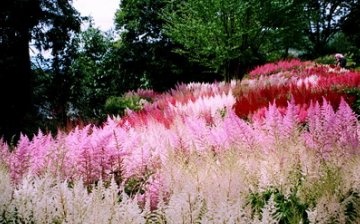Growing and caring for astilba
The astilba garden plant has long won the hearts of many gardeners due to its unpretentiousness, resistance to cold weather and, of course, magnificent and long-lasting flowering.
And although this plant does not really require much labor, growing and caring for astilba still includes some necessary activities.
Astilbe bushes retain their decorative effect even when they are not blooming. The merit in this is their double or triple dissected beautiful leaves. The peduncles of the plant are tall and represent panicles of small flowers of various colors.
Growing and caring for astilba, in order to be successful, must include the correct selection of the soil. This garden plant loves fertile, moisture-consuming, humus-rich soil.
Astilba bushes will grow better in partial shade conditions. If they are planted in an open, sunny place, then the plants will need to be watered very often and abundantly, as well as very carefully mulch the soil, which is necessary to protect the roots from overheating.
Weeding astilbe is necessary only at a young age, then its powerful roots drown out the growth of weeds.
Before wintering, astilbe bushes are cut to ground level and mulched with peat or earth. Although the plant is frost-hardy, some of its roots can be bare, they need shelter from the cold.
It is not recommended to grow astilba in one place for more than 5 years. To rejuvenate plantings, divide the bushes. If you start this process, then it will be very difficult to divide the old rhizomes, since they lignify.
The division of the bushes is performed in early spring or early autumn. This plant tolerates division without problems, the next year it is actively growing and delighting you with abundant flowering.



